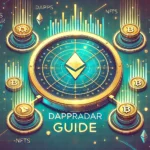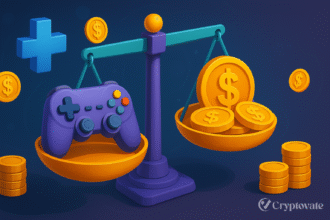– Ad –
| Getting your Trinity Audio player ready... |
If you’ve been watching the Web3 gaming space in 2025, you already know the numbers are getting too big to ignore. According to Precedence Research, the Web3 gaming market is expected to hit $37.5 billion this year. That’s not a hype bubble, that’s serious traction. DappRadar’s latest data shows 20M+ active wallets across gaming dApps, and NFT-based in-game assets are clocking in at over $10B in total sales.
- 1. Web3 Gaming vs Traditional Games: It Starts With Ownership
- 2. Play-to-Earn Games: Real Incentives, Not Just Entertainment
- 3. Web3 Games Still Lag in UX, But That’s Changing Fast
- 4. Blockchain Games Bring Power to the Players
- 5. Interoperability in Web3 Gaming: Endgame
- Final Thought: We’re Not Competing, We’re Expanding
- FAQs
But here’s the thing. Growth alone doesn’t mean much unless we unpack what’s different and valuable about Web3 games vs Traditional Games. I’ve had countless conversations with devs, investors, and gamers, and the same questions keep coming up. Let me explain it simply, avoiding the typical Web3 buzzwords.
1. Web3 Gaming vs Traditional Games: It Starts With Ownership
This is the first thing I tell anyone new to the space: Web3 gaming is about ownership. The gear, skins, and currencies they’re not just visuals on a screen. They’re assets you hold in your wallet. Not the studio’s. Yours.
Contrast that with traditional video games. You can spend hundreds of hours grinding or drop cash on a battle pass, but you don’t own anything. One ban, one server shutdown, and it’s gone.
Web3 flips that power dynamic. It’s not just game design, it’s a mindset shift. Ownership means portability, resale, and in some cases, revenue.
2. Play-to-Earn Games: Real Incentives, Not Just Entertainment
Here’s where a lot of traditional gamers get skeptical: Isn’t Play-to-Earn just another way to pump coins?
Fair question. Early models did lean too far into finance, not fun. But the space is evolving. What we’re seeing now is Play-and-Earn games that prioritize gameplay and reward players with value along the way. It’s not a job. It’s recognition.
You’re spending time, building skills, and growing economies. Why shouldn’t you share in that upside?
3. Web3 Games Still Lag in UX, But That’s Changing Fast
Let’s be honest, the UX gap between Web3 and traditional games is real. Web2 studios have decades of R&D, massive teams, and buttery-smooth interfaces. Web3 games still stumble over wallet connect pop-ups and network switches.
But I don’t see this as a red flag. I see it as a phase. Every tech wave starts rough. What matters is direction, and the direction is solid. We’re seeing better onboarding, abstracted wallets, and real-time Layer 2 scaling that make these experiences more playable by the day.
4. Blockchain Games Bring Power to the Players
This is one of the biggest reasons I believe in Web3 gaming long-term: player governance.
Traditional games are top-down. Publishers call the shots. Web3 is bottom-up. Token holders vote. DAOs experiment with everything from tournament formats to economy tweaks. Sure, it’s messy, but it’s also more democratic.
When you’re part of a game’s evolution, not just a customer, your loyalty deepens. Your voice matters. That’s a whole new level of engagement.
Also Read: The Ultimate Guide to Play-to-Earn Games: How to Earn Money Without Investment
5. Interoperability in Web3 Gaming: Endgame
We’ve all seen the pitch decks. “Bring your skin from one game to another.” Sounds great. Rarely works.
But I think that’s changing. Interoperability isn’t fully live yet, but the foundations are being laid, with standards like ERC-6551, with identity protocols, with game engines that talk to each other.
It’ll unlock shared worlds, composable gameplay, and portable digital identities. Traditional gaming simply can’t offer that. Web3 can.
Final Thought: We’re Not Competing, We’re Expanding
Here’s what I keep coming back to: it’s not Web3 vs traditional games like it’s a war. It’s Web3 expanding what gaming can be.
Traditional games are still the gold standard for immersive gameplay. But Web3 is building something complementary: ownership, open economies, and community governance. It’s not just about better graphics. It’s about better alignment between players, developers, and ecosystems.
So no, Web3 gaming isn’t perfect yet. But it’s doing something traditional games never could, giving players real power.
And that’s the difference worth betting on.
FAQs
What makes Web3 gaming different from traditional gaming?
Web3 gaming gives players true ownership of in-game assets like skins or gear through blockchain technology, allowing them to trade or sell them. Traditional games keep assets locked within the game, controlled by developers.
How do Play-to-Earn games work in Web3?
Play-to-Earn games reward players with valuable digital assets or tokens for their time and skill. Unlike early models focused on profit, modern Web3 games balance fun gameplay with meaningful rewards.
Why is Web3 gaming’s user experience (UX) not as smooth as traditional games?
Web3 games face UX challenges like wallet setup and network changes, but improvements in onboarding and faster blockchain scaling are closing the gap with traditional games’ polished interfaces.
How does Web3 gaming empower players?
Web3 games employ decentralized systems, such as DAOs, allowing players to vote on game features or rules. This player-driven approach differs from traditional games, where developers hold full control.

















